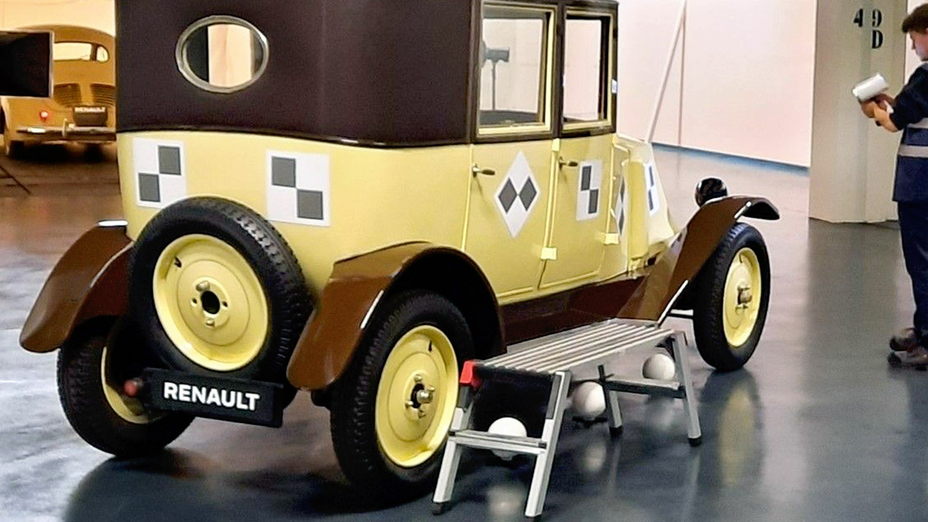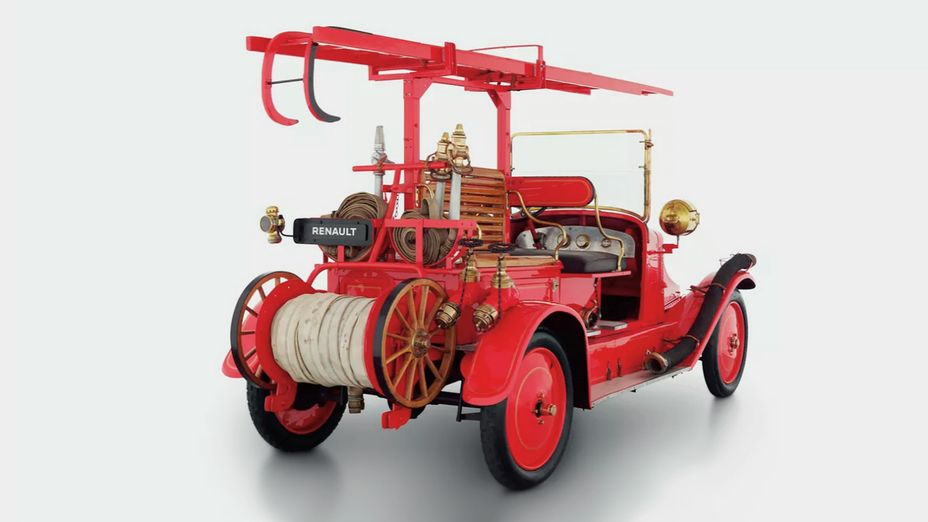Transforming 123 years of classic Renault cars into 3D with Artec Leo & Ray
Challenge: In order to win a highly competitive project, renowned French historical object and art digitalization specialist, Muséo 3D, needed a way to create incredibly lifelike virtual reproductions of dozens of French automaker Renault’s classic automobiles, some of which are more than a century old. What’s more, the project’s deadlines were ultra-tight, leaving no room for do-overs or less-than-pristine results.
Solution: Artec Leo, Artec Ray, Artec Studio, photogrammetry
Results: By creating a combined-scanner workflow consisting of the Artec Leo and Artec Ray, the Muséo 3D team, along with Artec Ambassador 3D Num, captured each car, bumper-to-bumper, inside-and-out, in under 4 hours. The resulting scans were then combined with photogrammetry and transformed into astonishingly realistic 3D models for the Renault Originals online virtual museum.
Why Artec? Because the Leo is the only scanner that makes it a cinch to capture all the organic and challenging shapes and textures of dozens of classic vehicles in high-resolution color 3D, inside and out, in record time, without any cables or laptop to get in the way.
In September 2021, when world-famous French auto manufacturer Renault announced its need for outside expertise on a project for creating an online virtual museum of its most iconic classic cars from the past 123 years, a frenzy of competition erupted.
The bidding was managed by Razorfish France, Renault’s digital agency in charge of this project. Among the five French companies vying for a chance to take part in this once-in-a-lifetime collaboration was Muséo 3D, a renowned specialist in the digitization of historical objects and works of art.

Scanning a Citroën 2CV with Artec Leo. Image courtesy of 3D Num
As a proof of concept to demonstrate their 3D capabilities, Muséo 3D, together with Artec Ambassador 3D Num decided to capture an old Citroën 2CV – including one which belonged to the grandfather of Muséo 3D photographer Raphaël Péméja.
Leo & Ray help take the gold
Via a synergy of Artec 3D scanners and photogrammetry, the results astounded everyone, including the judges, who summarily awarded the bid for the Renault Originals project to Museo 3D, giving them the green light to move ahead ASAP.

The final 3D model of the Citroën 2CV. Image courtesy of 3D Num
Once the project commenced, Museo 3D’s highly qualified team of specialists, along with 3D Num, captured 45 classic Renault vehicles from top to bottom and bumper to bumper, over the course of the next 3 weeks.
Such speed and comprehensive digitization, without any sacrifice in either accuracy or lifelike color reproduction, was made possible by the careful selection of 3D scanners: the handheld Artec Leo, and the tripod-mounted Artec Ray.
A synergy of Artec Leo and Artec Ray
The Artec Leo, a portable powerhouse, has been heralded for its exceptional accuracy, ease of use, and wireless functionality, a favorite among thousands worldwide in industries such as automotive, CGI, forensics, healthcare, and manufacturing.

Scanning the roof of a classic Renault car with Artec Leo (Artec Ray in the background). Image courtesy of 3D Num
Meanwhile, the Artec Ray, with its long-range scanning capabilities and precision, has become a go-to scanner for capturing large to massive objects for industrial design, architecture, and various construction sectors.
Due to the urgent nature of the project, Muséo 3D’s digitalization team was given a mere 4-hour window of time to complete the scanning (both interior and exterior) for each and every vehicle.
To accelerate their workflow even more, Muséo 3D and 3D Num utilized 3 Artec Leos with one Artec Ray, allowing them to capture three cars simultaneously, without losing even a fraction of a millimeter in accuracy or texture. The Leos had an added advantage above and beyond other handheld 3D scanners: AI-powered HD Mode.

Capturing the front of a Renault Type NN (1925) with Artec Leo. Image courtesy of 3D Num
An AI-powered algorithm that turbocharges the Leo scanner, HD Mode more than doubles the scanning resolution, from 0.5 mm to 0.2 mm, giving users the power to capture far finer details.
On top of that, HD processing diminishes noise on the surface of the model down to a minimum. As a result, Leo’s HD Mode scans look cleaner, sharper, and exceptionally lifelike.

The final 3D model of a Renault Juvaquatre (1939), in the Renault Originals online museum
Explaining their choice of the Leo, François Arnoul, president of 3D Num, said, “If we had tried to capture one single car at a time with another laser scanner, this would have taken us at least 2 days, without even scanning the interior of the car, because laser scanners don’t typically function well in such cramped conditions.”

The final 3D model of a Renault Type A (1898), in the Renault Originals online museum
Capturing the classics from bumper to bumper in just 4 hours
He continued, “But Leo easily captured the entire car and all its tiny details, inside and out, in just a handful of hours. And it’s so easy to use, training takes just an hour or two and you can achieve remarkable results, even when scanning complex, non-smooth fabrics and other such surfaces.”

Incredible 3D realism: looking down from the driver’s seat at the steering wheel of a Renault Type A (1898), in the Renault Originals online museum
Along with the scanning, for the photogrammetry piece of the puzzle, hundreds of high-definition, finely calibrated photos were taken of each car, making it possible for the final 3D model to have an exact, ultra-realistic rendering of the vehicle’s unique colorimetry.
Transforming the scans into magnificent 3D models
Once all the scanning was complete, the 150+ gigabytes of scan data (per car) were processed in Artec Studio software, a richly featured solution for intuitively transforming 3D scans into submillimeter-accurate 3D models ready for use in CGI, reverse engineering, and more.

The final 3D model of a Renault R12 Gordini (1970), in the Renault Originals online museum
These models were then exported, optimized, retopologized, and textured over the next 4 months by Muséo 3D’s talented team of experts.
Following this segment of the project, the remaining 30 classic Renault cars were then systematically scanned, bringing the total virtual vehicle count up to 75 cars, altogether adding up to a digital showroom that represents Renault quality engineering at its finest, for more than a century now.

The final 3D model of a Renault Laguna Concept Car (1990), in the Renault Originals online museum
Optimizing the workflow and saving 70 hours
During the project, 3D Num significantly optimized the original scan-to-3D model workflow, reducing the amount of time spent by 1 hour per vehicle. The time savings quickly added up, resulting in more than 70 hours saved across the duration of the project – a testament to the power of efficiency and innovation.

Bird’s-eye view of the 3D model of a Renault Laguna Concept Car (1990), in the Renault Originals online museum
“To meet Renault’s quality requirements, we were able to depend upon the excellent technical environment we had. It was a pleasure to reproduce in 3D with such accuracy the most remarkable historical models of the brand, some dating back to the end of the 19th century,” said Henry Elophe, Director of Muséo 3D.

The final 3D model of a Renault Type LO fire engine (1926), in the Renault Originals online museum
This project has opened up exciting new possibilities for the use of 3D scanning not merely in creating breathtakingly accurate virtual car museums, but also for promoting a vehicle manufacturer’s new models online, which Renault has recently begun doing in the wake of the success of the Renault Originals project.
Automotive 3D scanning: yesterday, today, and the road ahead
For more than a decade now, Artec scanners have been used worldwide for reverse engineering legacy and hard-to-source parts for classic cars of all makes and models, in addition to many other spheres and applications.

The future is now: 3D model of a Renault ZOE Z.E. Concept car (2009), in the Renault Originals online museum
This remarkable technology has allowed automotive enthusiasts and professionals alike to breathe new life into these prized vehicles, ensuring that their storied histories are preserved for future generations to appreciate and enjoy.
With the success of the Renault Originals project, the automotive industry has been given a glimpse into the potential of 3D scanning and digitization, proving that the road to innovation is paved with the tireless efforts of those who dare to push the boundaries of technology to the max.
Scanners behind the story
Try out the world's leading handheld 3D scanners.





